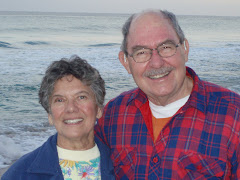Since I last posted on our blog, we have driven from Valdez to Haines, Alaska. Haines like Valdez is on the coast, but there is not a direct road from Valdez. We had to return to Tok, and then follow the Alaska Highway south into the Yukon Territory, Canada, then turn back southwest again into Alaska. It was not a particularly long trip --- about 450 miles – but we took our time --- five days. After we got to Tok, we traveled over a part of the Alaska Highway that was new to us, so we saw lots of new scenery, characterized by long ranges of mountains, and deep valleys, with large and small lakes. The road was characterized by numerous frost heaves and pot holes, so much of the way we were driving at thirty five miles per hour. We camped in Canadian Provencal Parks three nights. These parks are beautiful, usually near a lake or a creek, and in one case a waterfall, with large and level campsites, but no facilities to speak of --- that is no water, dump stations or electricity, so we were doing good old fashioned camping.
We are really enjoying Haines, Alaska. Haines is a small town at the head of a narrow bay or fjord. Our RV is in a park facing the waterfront. Our view out the front window is the bay is surrounded by high snow capped mountains. The town has been important for fishing and canning and processing salmon. It was also the head of a minor trail to the Klondike during the gold rush, but was not nearly as important as Skagway (which we will visit later this week). Although fishing is still important, the canneries are gone, and the fish are sold to company ships that take them elsewhere for processing. However out in the bay we see many little boats bobbing in the wave with their gill nets out for salmon.
We met some Escapee friend we had traveled with earlier on our trip, and with them we went to a nearby placer gold mine, about twenty miles from town, up in the mountains. The mine is run by an 87-year old gentleman, who was formerly in the lumbering business. He caters to tourists, although it is obvious he is serious about his mining. He is a raconteur, and knows a lot of the local history, so listen to him describe his mine and his early experiences in the lumber business, was as interesting as the gold panning. (Madeline got a few gold flakes, but not enough for us to forego social security checks.)
I visited a salmon canning museum. A local man here became interested in salmon canning, and went about collecting old canning equipment. The equipment probably would have been current in the 1920’s to 1940’s. Most interesting was how the old cans were made. American Can sold a tin-can cylinder which was compressed (folded) into a rectangle. A machine expanded this back into a cylinder. Then another machine crimped a can bottom on. Subsequent machines butchered the fish and placed it into the can and then an additional lid was sealed on.
We have seen bears and eagles around here. At one park, salmon are swimming upstream to spawn. There is a large grizzly bear there just about all the time, either fishing or eating the remains of cleaned fish, left by fishermen. Nearby in the trees we see an occasional eagle, I suppose also fishing. At another park, about 15 miles away, we saw a black bear, harvesting berries. I believe Madeline now has filled her quota of bear pictures.
My cousin, Henry Hopkins lives in Juneau, Alaska – a city about twenty miles from here which can only be reached by boat. Although there are roads in Juneau, they only connect to places near Juneau, but not to any main highway. Juneau is the capital of Alaska, and there is a constant movement to move the capital elsewhere – resisted, of course, by people who live in Juneau. Henry and his family visited us last evening, on route back home from a visit to Fairbanks. Tomorrow we will go down to visit them, and the take a whale-watching trip on Monday. Should be fun.
Sunday, August 12, 2007
Subscribe to:
Post Comments (Atom)

No comments:
Post a Comment